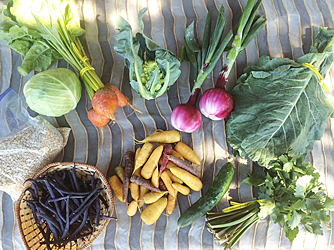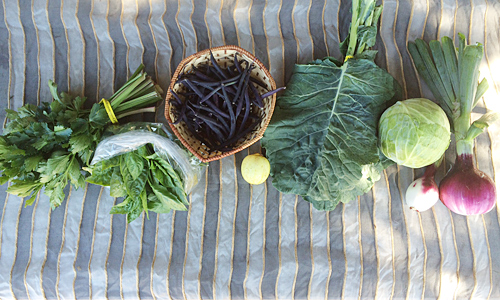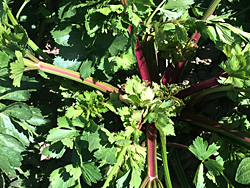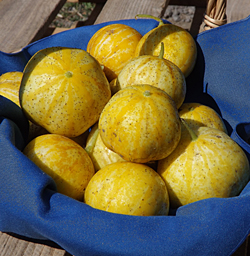In the Standard Box:

Rolled Oats 2 lb
Purple Beans 3/4 lb
Golden Beets with Greens 1 bu
Collards 1 bu
Green Cabbage 1 hd
Cucumber
Red Celery 1 bu
Red Onions 2
Rainbow Carrots 2 lb
Romanesco 1 hd
In the Small Box:

Purple Beans 1 lb
Basil 1/4 lb
Collards 1 bu
Green Cabbage 1 hd
Lemon Cucumber
Red Celery 1 bu
Red Onions 2
Red Celery

Red Celery is a highly versatile vegetable and a great source of antioxidants. If you like a real celery flavor, this one’s for you! It can be enjoyed in stews and casseroles; braised as a side to grilled meats and fish; and enjoyed raw in salads or as a carrier for a wide variety of dips.
One thing that makes this celery variety different from green celery is that it retains its color, flavor and texture well, even when cooked. It can be chopped fine into a salad, and it really dresses up a Bloody Mary!
Celery of all kinds were regarded as medicine by the ancients, but today commercial celery has been watered down to virtually a garnish. Red celery takes us back to the time when celeries were a real vegetable, with character and a heartiness and taste that satisfy.
Summer Salad with Red Celery
3 stalks red celery , julienne
1/2 head cabbage, julienne
2 medium carrots, julienne
1/2 red onion, finely diced
1/2 cup mayonnaise
1 dash salt
1 dash pepper
Add all the vegetables to a large salad bowl. Add the mayo, salt and pepper and combine thoroughly. Chill and serve as a cool summer side dish.
Collards

The collard is actually a type of kale, and although both are low-growing plants with robust leaves growing on sturdy stalks, collards are flat and paddle-shaped in contrast to kale’s often intricately curled or wrinkled
foliage.
Collards are forever associated in American cuisine with Southern soul food. It is thought that African slaves brought seeds of the vegetables they knew and loved from their homeland, including collards, black-eyed peas, and okra.
Collards have abundant amounts of vitamins A and C, folic acid, iron, fiber, and calcium. Per calorie, collards have more calcium than milk, are an excellent source of organic and highly absorbable iron, contain phenomenal amounts of vitamin K, and are also twice as high in vitamin A as carrots. Yet a 1-cup serving of chopped raw collards contains a mere 11 calories. Additionally, like other cruciferous vegetables, collards contain abundant amounts of phytonutrients, which have proved in studies to fight cancer.
- Add collards to soups and stews. They go especially well with ham and bacon.
- The liquid left after slow-cooking collards is extremely nutritious and delicious.
- Collards work well in any recipe calling for kale.
- Saute collards with chili flakes or hot peppers. Serve with cottage cheese or yogurt.
- Boil or steam with onion, garlic and plenty of chopped fresh herbs, like dill or basil.
- Lightly steam collard leaves for about 15 minutes, allow to cool, then use as a wrap for sautéed brown rice with onion, or ground pork, chicken or beef.
Please note: Your purple string beans will turn green as they cook.

Lemon cucumbers may resemble lemons, but they don’t have a lemony taste. They are a perfect serving size for one or two people, and the skin is very tender and the flavor a little milder than the traditional cuke. It is also less apt to get that slightly bitter taste after a few days.
